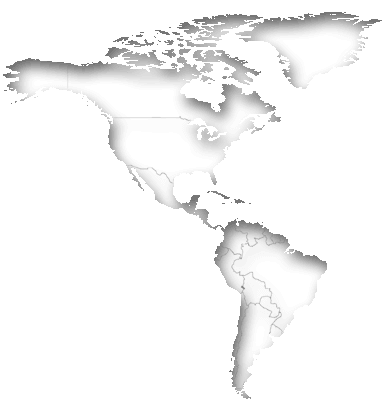
America
There are 1.03 billion people living in America — that's 13.0% of the world's population — and they account for around 34% of global economic output.
North America
Bermuda ¹CanadaGreenland ¹MexicoSaint Pierre and Miquelon ¹United States of AmericaCentral America
BelizeCosta RicaEl SalvadorGuatemalaHondurasNicaraguaPanamaSouth America
ArgentinaBoliviaBouvet Island ¹BrazilChileColombiaEcuadorFalkland Islands ¹French Guiana ¹GuyanaParaguayPeruSouth Georgia and South Sandwich Islands ¹SurinameUruguayVenezuelaCaribbean
Anguilla ¹Antigua and BarbudaAruba ¹BahamasBarbadosBritish Virgin Islands ¹Caribbean Netherlands ¹Cayman Islands ¹CubaCuracao ¹DominicaDominican RepublicGrenadaGuadeloupe ¹HaitiJamaicaMartinique ¹Montserrat ¹Puerto Rico ¹Saint Barthelemy ¹Saint Kitts and NevisSaint LuciaSaint Martin ¹Saint Vincent and the GrenadinesSint Maarten ¹Trinidad and TobagoTurks and Caicos Islands ¹Virgin Islands ¹American alliances and trade agreements
- ALBA - Bolivarian Alliance for America
- CAN - Andean Community of Nations
- CACM - Central American Common Market
- CARICOM - Caribbean Community and Common Market
- CELAC - Community of Latin American and Caribbean States
- Mercosur - Mercado Común del Sur
- NAFTA - North American Free Trade Agreement
- OAS - Organization of American States
- OECS - Organization of Eastern Caribbean States
- Pacific Alliance
- SICA - Central American Integration System
- USAN - Union of South American Nations
A point of contention occasionally arises in the allocation of Greenland to Europe or America. Greenland is a territory of the Danish Kingdom and thus politically belongs to Europe. Geographically, Greenland belongs to North America. The US state of Hawaii, on the other hand, belongs politically to America, but geographically and culturally to Polynesia.
In total, the double continent has a north-south extension of more than 15,600 kilometres (~9,700 miles) and stretches from the Arctic cape Morris Jesup in Greenland to the Chilean cape Hoorn. Canada, the USA and Brazil are by far the largest countries.
Discovery and naming
America was discovered in 1492 by Christopher Columbus, who assumed that he had landed in India. Amerigo Vespucci was the first to discover the Brazilian mainland and the eponym of the continent. By the way, the name of the natives as "Indians" is also based on Columbus' error. The term is not used in America itself. There one speaks mostly of Native Americans.Countries in Latin America
According to the most common international understanding, these are the 20 American countries where Spanish or Portuguese is predominantly spoken. However, the name "Latin" refers not only to Spanish and Portuguese, but to all the Romance languages, including French. If you add these countries, you get 28 countries including the French part of Canada.Within Brazil, the term "Latin America" is often used only for the Spanish speaking countries, thus excluding Brazil itself. Within the U.S., with the exception of Canada, all Spanish-, Portuguese- and French-speaking countries are considered Latin American. Occasionally, all countries south of the U.S. are counted as Latin American, including the Dutch Antilles and English-speaking countries such as Jamaica, the Bahamas, and Barbados.
Population
After the discovery of America around 1500 CE. more and more areas of the continent were colonized. The indigenous peoples of America were pushed further and further back. Internationally known are especially the Indians from numerous films. Further indigenous peoples are the Inuit or the Mayas.With the colonization, numerous Europeans came to the continent and founded ever larger cities. As early as the early 16th century, an estimated 12 million slaves were bought in West and Central Africa and transported across the Atlantic by ship. This only came to an end in the middle of the 19th century.
Most widely spoken native languages in America
| Language | Percentage | Population |
|---|---|---|
| Spanish | 40.6 % | 419.8 M |
| English | 29.1 % | 300.3 M |
| Portuguese | 19.5 % | 201.8 M |
| French | 1.6 % | 16.2 M |